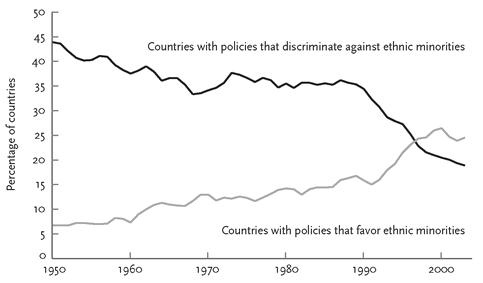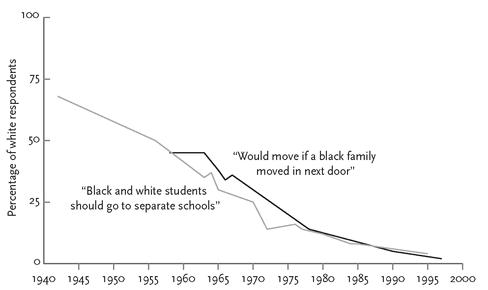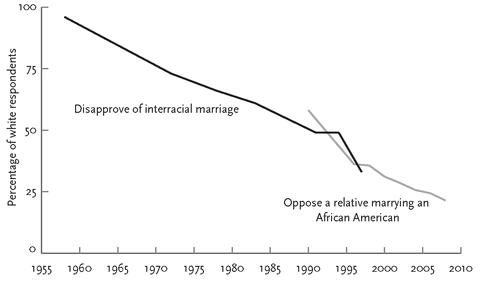The Better Angels of Our Nature: Why Violence Has Declined (88 page)
Read The Better Angels of Our Nature: Why Violence Has Declined Online
Authors: Steven Pinker
Tags: #Sociology, #Psychology, #Science, #Social History, #21st Century, #Crime, #Anthropology, #Amazon.com, #Retail, #Criminology

BOOK: The Better Angels of Our Nature: Why Violence Has Declined
2.09Mb size Format: txt, pdf, ePub

FIGURE 7–5.
Discriminatory and affirmative action policies, 1950–2003
Discriminatory and affirmative action policies, 1950–2003
Source:
Graph from Asal & Pate, 2005.
Graph from Asal & Pate, 2005.
The sociologist Lawrence Bobo and his colleagues decided to see for themselves by examining the history of white Americans’ attitudes toward African Americans.
26
They found that far from being indestructible, overt racism has been steadily disintegrating. Figure 7–6 shows that in the 1940s and early 1950s a majority of Americans said they were opposed to black children attending white schools, and as late as the early 1960s almost half said they would move away if a black family moved in next door. By the 1980s the percentages with these attitudes were in the single digits.
26
They found that far from being indestructible, overt racism has been steadily disintegrating. Figure 7–6 shows that in the 1940s and early 1950s a majority of Americans said they were opposed to black children attending white schools, and as late as the early 1960s almost half said they would move away if a black family moved in next door. By the 1980s the percentages with these attitudes were in the single digits.
Figure 7–7 tells us that in the late 1950s only 5 percent of white Americans approved of interracial marriage. By the late 1990s two-thirds approved of it, and in 2008 almost 80 percent did. With some questions, like “Should blacks have access to any job?” the percentage of racist responses had dropped so low by the early 1970s that pollsters dropped them from their questionnaires.
27
27

FIGURE 7–6.
Segregationist attitudes in the United States, 1942–1997
Segregationist attitudes in the United States, 1942–1997
Sources:
“Separate schools”: Data from Schuman, Steeh, & Bobo, 1997, originally gathered by the National Opinion Research Center, University of Chicago. “Would move”: Data from Schuman, Steeh, & Bobo, 1997, originally gathered by the Gallup Organization.
“Separate schools”: Data from Schuman, Steeh, & Bobo, 1997, originally gathered by the National Opinion Research Center, University of Chicago. “Would move”: Data from Schuman, Steeh, & Bobo, 1997, originally gathered by the Gallup Organization.

FIGURE 7–7.
White attitudes to interracial marriage in the United States, 1958–2008
White attitudes to interracial marriage in the United States, 1958–2008
Sources:
“Disapprove”: Data from Schuman, Steeh, & Bobo, 1997, originally gathered by the Gallup Organization. “Oppose”: Data from the General Social Survey (
http://www.norc.org/GSS+Website
).
“Disapprove”: Data from Schuman, Steeh, & Bobo, 1997, originally gathered by the Gallup Organization. “Oppose”: Data from the General Social Survey (
http://www.norc.org/GSS+Website
).
Also in decline are dehumanizing and demonizing beliefs. Among white Americans, these beliefs historically took the form of the prejudice that African Americans were lazier and less intelligent than whites. But over the past two decades, the proportion of Americans professing these beliefs has been falling, and today the proportion who profess that inequality is a product of low ability is negligible (figure 7–8).
Religious intolerance has been in steady decline as well. In 1924, 91 percent of the students in a middle-American high school agreed with the statement “Christianity is the one true religion and all peoples should be converted to it.” By 1980, only 38 percent agreed. In 1996, 62 percent of Protestants and 74 percent of Catholics agreed with the statement “All religions are equally good”—an opinion that would have baffled their ancestors a generation before, to say nothing of those in the 16th century.
28
28
The stigmatizing of any attitude that smacks of the dehumanization or demonization of minority groups extends well beyond the polling numbers. It has transformed Western culture, government, sports, and everyday life. For more than fifty years America has been cleansing itself of racist imagery that had accumulated in its popular culture. First to go were demeaning portrayals of African Americans such as blackface musical performances, shows like
Amos ’n’ Andy
and
Little Rascals
, films such as Walt Disney’s
Song of the
South
, and many Bugs Bunny cartoons.
29
Caricatures in logos, advertisements, and lawn ornaments have disappeared as well. The peak of the civil rights movement was a turning point, and the taboo was quickly extended to other ethnic groups. I remember as a child the 1964 rollout of a line of powdered drink mixes called Funny Face that came in flavors called Goofy Grape, Loud Mouth Lime, Chinese Cherry, and Injun’ Orange, each illustrated with a grotesque caricature. Bad timing. Within two years the latter two were made over into a raceless Choo Choo Cherry and Jolly Olly Orange.
30
We are still living through the rebranding of venerable sports teams that were based on Native American stereotypes, most recently the University of North Dakota Fighting Sioux. Derogatory racial and ethnic jokes, offensive terms for minority groups, and naïve musings about innate racial differences have become taboo in mainstream forums and have ended the careers of several politicians and media figures. Of course, plenty of vicious racism can still be found in the cesspools of the Internet and at the fringes of the political right, but a sharp line divides it from mainstream culture and politics. For instance, in 2002 the Senate Republican minority leader Trent Lott praised the 1948 presidential bid of Strom Thurmond, who at the time was an avowed segregationist. After a firestorm from within his own party, Lott was forced to resign his post.
Amos ’n’ Andy
and
Little Rascals
, films such as Walt Disney’s
Song of the
South
, and many Bugs Bunny cartoons.
29
Caricatures in logos, advertisements, and lawn ornaments have disappeared as well. The peak of the civil rights movement was a turning point, and the taboo was quickly extended to other ethnic groups. I remember as a child the 1964 rollout of a line of powdered drink mixes called Funny Face that came in flavors called Goofy Grape, Loud Mouth Lime, Chinese Cherry, and Injun’ Orange, each illustrated with a grotesque caricature. Bad timing. Within two years the latter two were made over into a raceless Choo Choo Cherry and Jolly Olly Orange.
30
We are still living through the rebranding of venerable sports teams that were based on Native American stereotypes, most recently the University of North Dakota Fighting Sioux. Derogatory racial and ethnic jokes, offensive terms for minority groups, and naïve musings about innate racial differences have become taboo in mainstream forums and have ended the careers of several politicians and media figures. Of course, plenty of vicious racism can still be found in the cesspools of the Internet and at the fringes of the political right, but a sharp line divides it from mainstream culture and politics. For instance, in 2002 the Senate Republican minority leader Trent Lott praised the 1948 presidential bid of Strom Thurmond, who at the time was an avowed segregationist. After a firestorm from within his own party, Lott was forced to resign his post.

FIGURE 7–8.
Unfavorable opinions of African Americans, 1977–2006
Unfavorable opinions of African Americans, 1977–2006
Sources:
Data from Bobo & Dawson, 2009, based on data from the General Social Survey (
http://www.norc.org/GSS+Website
).
Data from Bobo & Dawson, 2009, based on data from the General Social Survey (
http://www.norc.org/GSS+Website
).
The campaign to extirpate any precursor to attitudes that could lead to racial violence has defined the bounds of the thinkable and sayable. Racial preferences and set-asides are difficult to justify by rational arguments in a society that professes to judge people not by the color of their skin but by the content of their character. Yet no one in a position of responsibility is willing to eliminate them, because they realize it would decrease the representation of African Americans in professional positions and risk a repolarization of society. So whenever racial preferences are declared illegal or voted out in plebiscites, they are reframed with euphemisms such as “affirmative action” and “diversity” and preserved in workarounds (such as granting university admission to the top percentage of students in every high school rather than to the top percentage statewide).
The race-consciousness continues after admissions. Many universities herd freshmen into sensitivity workshops that force them to confess to unconscious racism, and many more have speech codes (ruled unconstitutional whenever they have been challenged in court) that criminalize any opinion that may cause offense to a minority group.
31
Some of the infractions for “racial harassment” cross over into self-parody, as when a student at an Indiana university was convicted for reading a book on the defeat of the Ku Klux Klan because it featured a Klansman on the cover, and when a Brandeis professor was found guilty for mentioning the term
wetback
in a lecture on racism against Hispanics.
32
Trivial incidents of racial “insensitivity” (such as the 1993 episode in which a University of Pennsylvania student shouted at some late-night revelers to “Shut up, you water buffalo,” a slang expression for a rowdy person in his native Hebrew that was construed as a new racial epithet) bring universities to a halt and set off agonized rituals of communal mortification, atonement, and moral cleansing.
33
The only defense of this hypocrisy is that it may be a price worth paying for historically unprecedented levels of racial comity (though it’s in the nature of hypocrisy that one cannot say that either).
31
Some of the infractions for “racial harassment” cross over into self-parody, as when a student at an Indiana university was convicted for reading a book on the defeat of the Ku Klux Klan because it featured a Klansman on the cover, and when a Brandeis professor was found guilty for mentioning the term
wetback
in a lecture on racism against Hispanics.
32
Trivial incidents of racial “insensitivity” (such as the 1993 episode in which a University of Pennsylvania student shouted at some late-night revelers to “Shut up, you water buffalo,” a slang expression for a rowdy person in his native Hebrew that was construed as a new racial epithet) bring universities to a halt and set off agonized rituals of communal mortification, atonement, and moral cleansing.
33
The only defense of this hypocrisy is that it may be a price worth paying for historically unprecedented levels of racial comity (though it’s in the nature of hypocrisy that one cannot say that either).
In
The Blank Slate
I argued that an outsize fear of reintroducing racial hostility has distorted the social sciences by putting a heavy thumb on the nurture side of the nature-nurture scale, even for those aspects of human nature that have nothing to do with racial differences but are universal across the species. The underlying fear is that if
anything
about human nature is innate, then differences among races or ethnic groups might be innate, whereas if the mind is a blank slate at birth, then all minds must start out equally blank. An irony is that a politicized denial of human nature betrays a tacit acceptance of a particularly dark theory of human nature: that human beings are perpetually on the verge of a descent into racial animus, so every resource of the culture must be mobilized against it.
WOMEN’S RIGHTS AND THE DECLINE OF RAPE AND BATTERINGThe Blank Slate
I argued that an outsize fear of reintroducing racial hostility has distorted the social sciences by putting a heavy thumb on the nurture side of the nature-nurture scale, even for those aspects of human nature that have nothing to do with racial differences but are universal across the species. The underlying fear is that if
anything
about human nature is innate, then differences among races or ethnic groups might be innate, whereas if the mind is a blank slate at birth, then all minds must start out equally blank. An irony is that a politicized denial of human nature betrays a tacit acceptance of a particularly dark theory of human nature: that human beings are perpetually on the verge of a descent into racial animus, so every resource of the culture must be mobilized against it.
To review the history of violence is to experience repeated bouts of disbelief in learning how categories of violence that we deplore today were perceived in the past. The history of rape provides one of those shocks.
Rape is one of the prime atrocities in the human repertoire. It combines pain, degradation, terror, trauma, the seizure of a woman’s means of perpetuating life, and an intrusion into the makeup of her progeny. It is also one of the commonest of atrocities. The anthropologist Donald Brown includes rape in his list of human universals, and it has been chronicled in every age and place. The Hebrew Bible tells of an era in which the brothers of a raped woman could sell her to her rapist, soldiers were entitled by divine decree to ravish nubile captives, and kings acquired concubines by the thousands. Rape, we have seen, was also common in tribal Amazonia, Homeric Greece, medieval Europe, and England during the Hundred Years’ War (in Shakespeare’s account, Henry V warns a French village to surrender or else their “pure maidens [will] fall into the hand of hot and forcing violation”). Mass rape is a fixture in genocides and pogroms all over the world, including recent rampages in Bosnia, Rwanda, and the Democratic Republic of the Congo. It is also common in the aftermath of military invasions, such as by the Germans in Belgium in World War I, the Japanese in China and the Russians in Eastern Europe in World War II, and the Pakistanis in Bangladesh during its war of independence.
34
34
Brown notes that while rape is a human universal, so are proscriptions against rape. Yet one has to look long and hard through history and across cultures to find an acknowledgment of the harm of rape
from the viewpoint of the victim
. “Thou shalt not rape” is not one of the Ten Commandments, though the tenth one does reveal the status of a woman in that world: she is enumerated in a list of her husband’s chattels, after his house and before his servants and livestock. Elsewhere in the Bible we learn that a married rape victim was considered guilty of adultery and could be stoned to death, a sentence that was carried over into Sharia law. Rape was seen as an offense not against the woman but against a man—the woman’s father, her husband, or in the case of a slave, her owner. Moral and legal systems all over the world codified rape in similar ways.
35
Rape is the theft of a woman’s virginity from her father, or of her fidelity from her husband. Rapists can redeem themselves by buying their victim as a wife. Women are culpable for being raped. Rape is a perquisite of a husband, seigneur, slave-owner, or harem-holder. Rape is the legitimate spoils of war.
from the viewpoint of the victim
. “Thou shalt not rape” is not one of the Ten Commandments, though the tenth one does reveal the status of a woman in that world: she is enumerated in a list of her husband’s chattels, after his house and before his servants and livestock. Elsewhere in the Bible we learn that a married rape victim was considered guilty of adultery and could be stoned to death, a sentence that was carried over into Sharia law. Rape was seen as an offense not against the woman but against a man—the woman’s father, her husband, or in the case of a slave, her owner. Moral and legal systems all over the world codified rape in similar ways.
35
Rape is the theft of a woman’s virginity from her father, or of her fidelity from her husband. Rapists can redeem themselves by buying their victim as a wife. Women are culpable for being raped. Rape is a perquisite of a husband, seigneur, slave-owner, or harem-holder. Rape is the legitimate spoils of war.
Other books
Wanting Wilder by Michele Zurlo
The Darkroom of Damocles by Willem Frederik Hermans
Courting Cate by Leslie Gould
PS02 - Without Regret by R.L. Mathewson
Nobody Said Amen by Tracy Sugarman
The Uncertain Customer by Pearl Love
Ida a Novel by Logan Esdale, Gertrude Stein
Voyage of the Sanguine Shadow 1: Shadow Galactic by Erik P. Harlow
Hillside Stranglers by Darcy O'Brien
Empire Girls by Suzanne Hayes